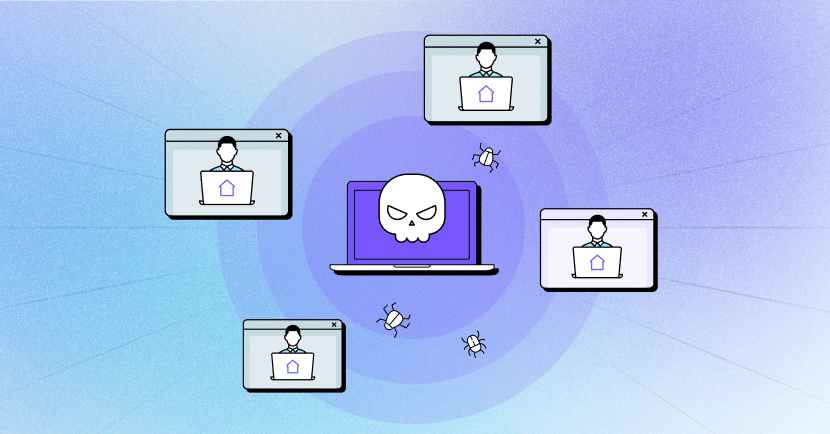Globalization and cloudification have enabled the adoption of remote and hybrid work models. This new workstyle provides businesses and employees with unprecedented flexibility, access to a global talent pool, and the ability to expand to new markets, among several other benefits. However, it has also driven a new risky practice: Shadow IT.
“Shadow IT” is the use of unauthorized software, applications, devices, and hardware within an organization. This could include unapproved SaaS apps, GenAI applications, USB flash drives, personal mobile devices, and much more. Employees often resort to these unsanctioned tools to complete their tasks in a quicker and easier manner, instead of having to wait for official approval and security protocols. But while these tools may offer short-term convenience, they pose significant security risks, including data breaches and compliance issues. This is the meaning of shadow IT.
Understanding and mitigating the risks of shadow IT is an important component in an organization’s security posture. In this article, we’ll explain the risks of Shadow IT, what constitutes Shadow IT and how to strengthen your organization’s cybersecurity posture.
What are the Different Aspects of Shadow IT?
The term “Shadow IT” comprises the wide range of unauthorized hardware and software that employees use within an organization without the knowledge or approval of the IT and security departments. Some Shadow IT examples include:
- SaaS applications, e.g., messaging apps, project management tools, cloud storage solutions, file-sharing platforms, and document-editing products.
- Web applications, e.g., GenAI applications and personal email accounts.
- Browser extensions
- Personal devices, e.g., personal laptops, smartphones, USB flash drives, and even IoT devices like smart speakers or wearables,
- Public wi-fi networks
What are the Challenges that Shadow IT presents?
According to Gartner, in 2022 41% of employees created, acquired or modified technology outside of IT’s visibility. The percentage is expected to grow to 75% in 2027. This growing use of shadow IT within organizations has created numerous challenges for organizations, including:
Security Risks
Unauthorized applications and devices are not bound to the same security protocols as approved IT resources. This makes them more vulnerable entry points for cyberattacks. For example, unsanctioned SaaS applications could more easily introduce malware and unauthorized devices could be points of access and backdoors for attackers. The resulting data breaches could result in financial losses, reputational damage and legal implications, created by Shadow IT risks.
Lack of Compliance
Many organizations are required to comply with various regulations, from SOC 2 and ISO 27001, to GDPR and CCPA, to HIPAA and PCI DSS, depending on their industry and location. The use of non-compliant software or hardware might mean regulatory requirements aren’t being met. This could have legal consequences and result in fines and sanctions.
Data Governance
Shadow IT prevents holistic data governance. When employees use unsanctioned tools, organizations lack transparency into where their data is stored and how it is being used. This makes it difficult to track and manage, which could result in operational efficiency, business impediment due to inability to derive the best insights, and compliance issues.
Operational Slowdown
The use of multiple, disparate tools can lead to data silos and reduced productivity. For example, important information might be stored in an unauthorized cloud service that is not accessible to other team members, leading to delays and miscommunication.
Inefficient Resource Allocation
IT departments usually operate under tight budgets and timelines. The time and effort spent on identifying and managing shadow IT could be used for driving initiatives that would turn the IT and security teams into a business enabler.
What are the Benefits of a Shadow IT Solution?
Implementing a shadow IT solution is a strategic move that offers multiple cybersecurity and operational benefits to an organization while supporting the implementation of your Shadow IT policy. These include:
Improved Security Posture
A shadow IT solution can provide visibility into the use of unsanctioned apps, browser extensions, and devices. By identifying any unapproved use, monitoring user actions, analyzing risks, alerting in case of a threat, and even blocking usage, such a solution reduces the risk of vulnerability exploitation. This means the solution can help with mitigating malware, preventing compromised credentials, and blocking malicious or inadvertent data exposure. This proactive approach ensures that only secure tools are in use, safeguarding the organization’s data and intellectual property.
Compliance Assurance
A shadow IT solution helps meet the stringent compliance requirements. This is done by ensuring that all data is stored and processed through authorized channels. Such activity not only minimizes the risk of legal repercussions but also builds customer trust.
Operational Efficiency
Centralizing IT operations improves collaboration and streamlines processes. This leads to better resource utilization and increased productivity.
Resource Optimization
IT departments are often stretched thin. They have to juggle multiple tasks, from maintenance to innovation. A shadow IT solution automates the process of identifying and managing unauthorized tools, freeing up IT personnel to focus on more strategic initiatives that drive business growth.
Cost Savings
Unchecked shadow IT can result in redundant spending on software licenses and maintenance while wasting employees’ valuable time. A comprehensive solution provides visibility into software usage, allowing organizations to eliminate redundancies and negotiate better terms with vendors.
Apply Shadow IT in your Organization
Shadow IT is an ubiquitous issue that organizations can not afford to ignore. There are significant short and long-term risks that result from the cybersecurity vulnerabilities, compliance issues, and operational inefficiencies. Therefore, proactively managing and mitigating the risks of shadow IT is essential for securing digital assets and maintaining a streamlined operational framework.
The LayerX enterprise browser extension protects the enterprise from web-borne risks, including those that result from the use of Shadow IT. LayerX provides IT and security teams with visibility into any Shadow IT usage, including unsanctioned apps, browser extensions, and devices. Unauthorized actions are monitored and analyzed and can be alerted about or blocked altogether. This helps mitigate the use and risk of Shadow IT, including malware, data exfiltration, and more.
Learn more about the LayerX Shadow IT solution here.




